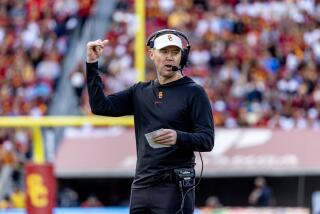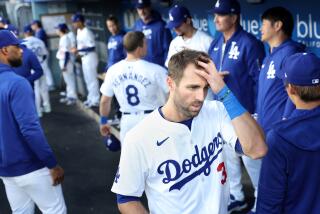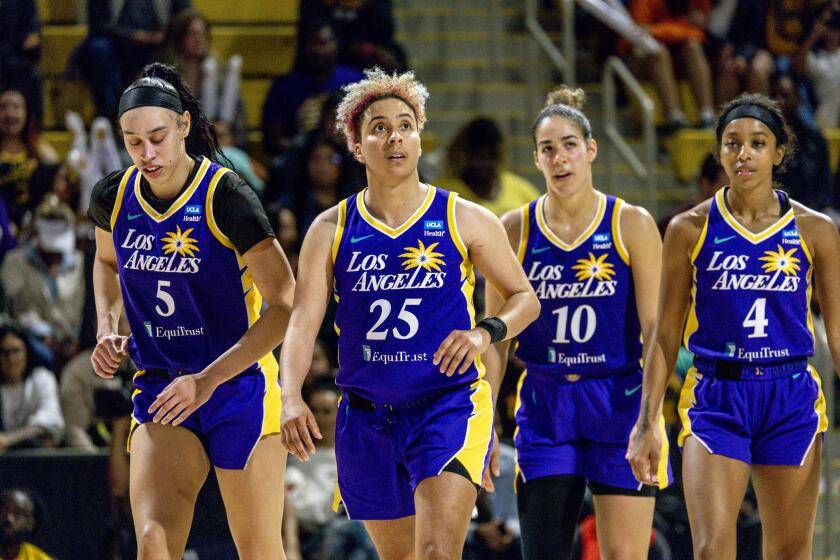Where Camp Is Cooler
The breeze is sweet on this cloudy morning, bursts of cool air off the Pacific. When the puffs of wind arrive, a dozen, maybe two dozen San Diego Charger football players turn their faces west, toward the ocean, toward that blowing air.
At this time of year, in training camp, the Chargers are the envy of everyone in the NFL. Training camp is less than a mile from the ocean, at UC San Diego. It is a most perfect summertime plot of land, a place where the heat is regulated, where the humidity can be cut with a string and not a knife.
There is never a comfortable time in the summer to put on football pads and pants, with all that tape wound around ankles, knees and backs. Big men running hard, hitting hard, breathing hard will generate heat and sweat and an ocean breeze can’t make the heat go away.
But it helps.
The day after Korey Stringer, a player for the Minnesota Vikings, died at his training camp, died because he was a proud man, a fierce competitor and absolutely not a man to ask for favors or to do one for his body, the Chargers gathered as usual. To practice. As usual.
There were no obvious signs of sadness over Stringer’s death or talk about heat indexes or hydration or what to do if you started vomiting during practice. It is not the way of NFL athletes to dwell on sickness or injury or even death.
In some way, all of these players know, deep inside, that something awful could happen to them on the football field. They could ruin a knee or hip or Achilles’ tendon. They could make a head-on tackle the wrong way and lose feeling in their arms and legs. Maybe the feeling will come back. Maybe it won’t.
They don’t expect to drop dead on the practice field, but they might not do anything to stop themselves from dropping dead, either.
Marcellus Wiley, a 6-foot-4, 275-pound defensive end from Los Angeles, talked Thursday of how he suffered from severe heat prostration several times when he played college football at Columbia.
“We’d be practicing in the city [New York] in August and the humidity would just be killing you,” Wiley said, missing the sad irony of his words. “More than once I’d get sick on the field, then be all cramping and sore and woozy and someone would finally have to lead me off the field.
“The thing is, I’d always have to be led. In my experience, no football player at this level is going to take himself off. You don’t get to be where we are by walking off the field because you feel sick.”
When he left the practice field Tuesday, Stringer’s body temperature was 108 degrees. He finished practice before asking for a trainer. Wiley understands this.
“It doesn’t make sense to most people but it does to us,” Wiley said. “You go home every night during the season and it hurts too much to pick up your 2-year-old child. You go home after every game and at 3 a.m. you’re up and it hurts.
“That’s what the season is like. In the preseason you have to learn how to take what’s going to come in the season. You can’t quit because of pain. You sure can’t quit because you threw up.”
Wiley is a smart, sensitive, Ivy League-educated man.
Yet Wiley stood outside his dorm room the day after a man died doing exactly what Wiley does and said that even having Stringer’s symptoms, Wiley wouldn’t take himself off the field.
“Someone else would have to do it,” he said. “Players will not stop. Someone else will have to stop them.”
Supposedly the Chargers have considered moving their training camp as soon as next summer to UC Riverside. When it’s 70 in La Jolla, it might be 90 or hotter in Riverside. Where there is a breeze in La Jolla, there is dead air in Riverside.
Charger General Manager John Butler said that the Riverside rumor was only that. A rumor.
“The only reason anybody has said anything about Riverside is because their president has talked about it,” Butler said Thursday. “Many factors are considered when you talk about making a move and about what makes a good training camp site. Many factors.”
Would heat be one of those factors?
“I imagine it would, yes,” Butler said.
Imagine if it weren’t. Imagine wearing pounds of gear and hauling your 250-pound or 300-pound or 320-pound body around the desert for two hours in the morning and two or three more in the afternoon.
Imagine that you knew if you threw up or passed out there would probably be a picture of you in the next day’s paper, as there was of Stringer on Tuesday. Or imagine that some fan who had watched practice called the talk-radio station the afternoon you vomited three times to make fun of you.
Imagine the guff your teammates would give if you were driven off the field on a cart. Imagine what you know the coaches would be saying at night in the meeting rooms.
“We think of all those things,” Wiley said. “If a team wants you to stop, then the team better stop you because we won’t stop ourselves.”
These players are expected by their owners, their coaches, their fans and the media to play hurt, tired, sick. It’s why they get all that money. They are the best of the best and the best don’t quit. Unless someone else makes them.
So someone else better start helping them off the field or keeping them off sometimes. And moving them to Riverside? Stop that too.
*
Diane Pucin can be reached at diane.pucin@latimes.com.
*
RELATED STORIES
The Day After: Dennis Green called it his most difficult day on the practice field as the Vikings tried to get back to business. D14
Tripped Up: Detroit receiver Herman Moore separated his right shoulder in practice, and it’s not clear when he will return. D13
Scary: Jacksonville safety Craig Miller was taken off on a stretcher after injuring his neck in practice. X-rays were negative. D13
More to Read
Get our high school sports newsletter
Prep Rally is devoted to the SoCal high school sports experience, bringing you scores, stories and a behind-the-scenes look at what makes prep sports so popular.
You may occasionally receive promotional content from the Los Angeles Times.






